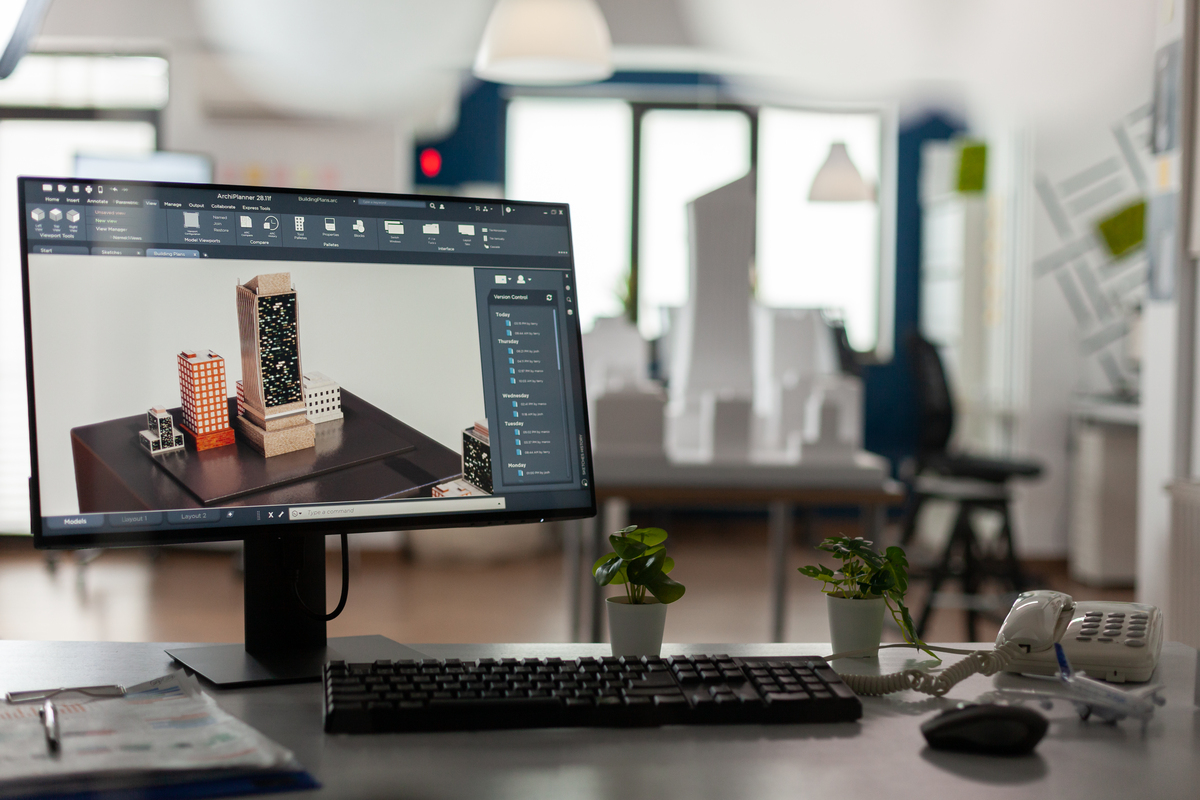Innovation and building design and construction methods are two areas in the always-changing field of architecture. A highly promising and interesting development in recent years has been the incorporation of artificial intelligence (AI) into architectural procedures. AI has the power to completely change the design industry, from improving visualization to coming up with new concepts for designs. Even though architectural design is linear, AI has various applications. Text-to-image generators and AI rendering plugins are just two examples of innovative technologies that many architects are already incorporating into their design processes.
More opportunities than ever exist for architects to begin utilizing AI in the intelligent design process, and it’s getting easier than ever to integrate AI into all design disciplines because of developments in AI technologies like ChatGPT, Dall-E, and MidJourney. AI will improve the efficiency of architectural design, but AI tools can help with repetitive chores. Designers have to follow this approach, which includes prototyping, risk management, BIM implementation, cost control, and AI integration at every stage of the architectural design process.
AI in architecture design is built on computer systems that simulate human cognition to tackle challenging issues and react quickly to stimuli. Machine learning, which describes an AI in architecture system’s capacity to identify patterns and learn from them to autonomously enhance its cognitive capacity without the assistance of a human, is a closely related subfield.
AI is becoming more and more relevant in the architectural design process. With brief text instructions, image generators such as Midjourney can create nearly photographic quality images with rich details by analyzing photographs from the Internet. This can be the digital counterpart of a detailed napkin sketch and can be a significant help with early concept brainstorming. These photos can also be utilized to reach a wider audience by illuminating fundamental design concepts and situations in marketing and promotional materials.
Table of Contents
Why Should Professionals Care About AI in Architecture?
‘Why should I worry about AI in architecture?’ is a question that may cross the minds of architects, designers, and executives in real estate management. This is a legitimate query that deserves a thorough answer. Gaining an understanding of and ability to use AI in architecture can significantly change your work, opening up a world of possibilities and improving your execution and design processes. Why therefore should you be interested in AI in your line of work?
- Innovation: AI in architecture provides cutting-edge solutions that can streamline difficult tasks and help you beat the competition.
- Efficiency: You can use AI in architecture to significantly reduce the time you spend on repetitive work, which will free up more time for creative endeavors.
- Precision: AI can provide hitherto undiscovered insights, enabling you to analyze and resolve design problems with previously unheard-of precision.
- Sustainability: AI in architecture encourages a more sustainable future in design by optimizing energy and choosing wisely when choosing materials.
- Competitive Advantage: You differentiate yourself from the competition by utilizing AI in architecture, which makes your designs more original, creative, and effective.
In the fields of architecture and engineering, AI in architecture serves as a stimulus for creativity and innovation in addition to being a means of enhancing efficiency. Underestimating its influence would be a waste of time in a field that depends so heavily on development and foresight.
Suggested article to read: Artificial Intelligence or AI in Construction Industry; Guide to 2024

Understanding Artificial Intelligence in Architecture
Artificial Intelligence, or AI for short, is the pinnacle of modern technological development. This innovative technology is significantly changing several professional domains, with architecture and design being two of the most notable.
- Fundamentally, AI in architecture is a multidisciplinary field that combines elements of psychology, computer science, and advanced mathematics to develop systems with the ability to learn, reason, solve problems, perceive, and comprehend language.
- The use of this concept in the field of architecture has resulted in a significant change in the way experts plan, design, optimize, and oversee infrastructure projects and buildings.
AI has several transformational applications in architecture, ranging from automating monotonous chores to recommending the best design solutions based on numerous aspects.
Suggested article to read: Top 20 Construction AI Companies; 2024 Review
How to Use AI in Architecture
Using automated technologies to manage site and contextual data can help remove uncertainty and, hopefully, risk before designers start producing versions. Designers and developers who are not programmers can now more easily handle complex, programming-intensive tasks thanks to these technologies. The following examples demonstrate how AI in architecture can open doors to better the design process so that human creativity can take center stage, ranging from research projects to commercial solutions.
Suggested article to read: The 18 Best AI Architecture Generators of 2024
1. Exploring AI Applications in the Design Process
You’ll find many uses of AI in architecture as you learn more about the fields of engineering and architecture. With the help of these apps, you can create designs that are more accurate, creative, and environmentally friendly. This is where AI is useful:
- Automated Design Generation. Just picture being able to come up with hundreds of different design alternatives in a fraction of the time it would normally take. AI in architecture is precisely capable of this. By integrating Generative Adversarial Networks (GANs), AI can automatically generate hundreds of design options based on specified factors, such as the size of the structure, the layout of its spaces, or the standards for energy usage. AI handles the first design prototyping, freeing you up to concentrate on other important project components.
- Precision Modelling. Accurate architectural model creation is another task that Generative Design AI in architecture can help with. These models take into account specifics such as the building’s traffic flow, temperature management, light direction, and structural integrity. Therefore, you can use AI modeling to make sure that your designs are workable, environmentally friendly, and visually pleasing.
- Real-Time Design Changes. Sometimes, don’t you wish you could instantly see how your design decisions are being received? This is made possible via AI in architecture. AI-powered software can give you immediate feedback on your design decisions so you can see the results of changing the parameters. You may easily test out various climatic efficiencies, materials, and layouts and view the results right away on your screen.
- Intelligent Resource Management. AI in architecture can assist you in making your designs more sustainable. AI in architecture can analyze data, spot possible wasteful areas, and make recommendations for how best to use available resources. AI enables you to design with efficiency, minimizing heat loss and making the most use of sunlight. This allows you to build designs that perfectly encapsulate the ideals of sustainable architecture.
Incorporating AI into your process has the potential to revolutionize it. AI in architecture not only increases your output and enhances the quality of your designs, but it also gives you the ability to develop long-lasting, sustainable solutions.
Suggested articles to read: Artificial Intelligence or AI in Building | Automation in Construction
2. Revolutionizing Architectural Visualization with AI
Imagine being able to see your architectural plans with a level of realism never previously possible—that is precisely what artificial intelligence (AI) brings to the field of architectural design. Architects and engineers can now create animated, hyper-realistic 3D simulations of their projects by combining AI technology with visualization tools. This is a game-changing tool for client presentations in addition to being helpful for the design process.
Through the advancement of technologies such as virtual reality, augmented reality, and real-time rendering, artificial intelligence is creating new opportunities in the field of design visualization. Let’s investigate these fascinating fields and discuss what they mean for engineers and architects working in these fields.
- Rendering in Real Time. The process of producing renderings used to be laborious and time-consuming, especially for intricate designs or big projects. AI-powered real-time rendering modifies all of that. The rapid visualization of design modifications made possible by this technology significantly reduces the time it takes to receive visual feedback on proposals. Quick iteration and refinement of designs not only streamline the process but also help in improved client communication.
Suggested article to read: 13 Best Architectural Rendering Software; 2024 Review
- AR and VR Stand for Virtual and Augmented Reality. Other fields of architectural visualization that AI has transformed include virtual reality (VR) and augmented reality (AR). Architects may now use virtual reality (VR) to produce completely realistic, interactive presentations of their designs instead of using static 2D drawings and 3D models. Virtual reality experiences driven by AI enable spectators to ‘walk about’ within a structure even before construction begins, enabling them to fully understand the subtleties of the design. AR, on the other hand, takes things a step further by allowing engineers and architects to overlay a 3D model of a suggested design onto an actual setting, greatly improving our comprehension of how the building will interact with its surroundings.
Suggested articles to read: Virtual Reality in Construction; VR Ultimate Guide 2024 | Explore the Impact of Augmented Reality in Construction (2024)
- GANs’ (Generative Adversarial Networks) Potential. Another area of artificial intelligence that is gaining traction in architectural visualization is Generative Adversarial Networks (GANs). Based on specified parameters, GANs can be trained to produce realistic photographs of structures. Because of the variety of potential design alternatives that this technology generates, each one unique in its way, it may lead to new sources of inspiration for designers.

3. Optimizing Building Performance with AI in Architecture
Envision a future where buildings function flawlessly in addition to having an excellent appearance. With its ability to do accurate and data-driven analysis, AI in architecture carries with it this reality. By processing and analyzing enormous volumes of data, AI in architecture produces solutions that preserve resources, lower energy consumption, and guarantee occupant comfort over time. This greatly improves the performance of buildings.
You may be wondering, though, how AI in architecture manages to pull off all of these amazing accomplishments.
- AI-Driven Operational Efficiency. Real-time data gathering and interpretation are made possible by the integration of AI into architecture in conjunction with sensors and smart devices. This gives engineers and architects the knowledge they need to come up with solutions for the best possible operating efficiency. Significant energy savings can be achieved by automatically adjusting the lighting, temperature, or ventilation depending on data, presence detection, or behavior prediction. Early detection of possible system problems can also reduce expenses and downtime.
- Predictive Maintenance and AI. AI in architecture is adept at forecasting future events in addition to responding to current ones. Predictive maintenance brings this to light since AI in architecture can identify problems with systems or equipment before they become serious, allowing for proactive preventative care. Such studies guarantee the building’s occupants’ continuous comfort in addition to lowering repair costs and extending the system lifespan.
- AI for Whole Building Operation. Artificial Intelligence is capable of analyzing a building as a whole ecosystem in addition to specific system performance. By evaluating building performance on this scale, engineers and architects may optimize how one system functions and interact with the others. This results in balanced building behavior that maximizes user comfort, structural integrity, and energy efficiency—all critical factors in establishing a warm and sustainable environment.
You work as an engineer or architect. You can influence performance optimization at every stage of the building lifecycle right in your palm. Predictive maintenance, improved operating productivity, and comprehensive building performance are all at your disposal. Consider the cutting-edge creations and technical achievements you could accomplish. This is not only feasible but also achievable and sustainable with AI in architecture.
Suggested article to read: Building Energy Optimization; Comprehensive Guide 2024
4. Unlocking Creativity through AI in Architecture
If you’re thinking about incorporating AI in architecture strategy, take this into account: AI can change the game by providing a means of unleashing creativity itself, rather than only serving as a tool for administrative or computational duties. Although the idea may initially appear strange or even frightening, it is an unavoidable fact that you should start understanding straight now.
With artificial intelligence (AI), you can explore and create in a unique environment free from the possible risks and financial burdens associated with physical modeling. Before anything is approved for building, you can experiment in a virtual setting with various ideas, approaches, and materials. With AI guiding you, you can push limits and venture into unexplored creative and design territory.
- Creative Partner: Envision AI in architecture as a creative partner, one that broadens your perspective by offering new insights and challenging your traditional concepts. It can quickly produce a plethora of design concepts, some of which you may not have even imagined, assisting you in breaking free from recurring patterns and expanding your creative horizons.
- Precision and Detail: You can look more closely at the specifics because of AI’s ability to handle massive volumes of data precisely. It can precisely forecast each design element’s ramifications, providing you with a clear picture of the expected result.
- Time Efficiency: AI in architecture frees up time by automating repetitive processes, allowing you to devote more of your valuable hours to creative work rather than tackling menial tasks. This includes conceptualization and design.

5. AI-Assisted Sustainable Design Solutions
It’s hard to overlook how AI may help assist green architecture as we transition to a more sustainable future. Not only are AI-assisted sustainable design solutions popular, but they are also a crucial component of contemporary architecture, providing a viable means for engineers and architects to solve environmental issues.
These technologies use AI to help architects choose environmentally friendly options at every stage of the design process. AI can analyze large amounts of data, such as energy consumption, sun orientation, and local weather patterns, to recommend design changes that can lower a building’s carbon footprint. The advantages don’t end there, though; let’s examine how integrating AI might completely transform sustainable design.
- Data-driven decision-making: Using AI in architecture, architects may make well-informed choices from the very beginning of the design process. AI can forecast sustainability metrics and energy usage under various design conditions by using sophisticated data analysis. AI makes sustainability less guessing by making precise predictions that help create eco-friendly and effective buildings.
- Optimizing Material Use: AI in architecture can help strike a balance between design aesthetics and eco-friendly material use. AI in architecture can suggest the most sustainable solutions, maximizing resource utilization and minimizing waste, by analyzing the energy impact of different materials.
- Simulation and Testing: AI-enabled simulations allow architects to test their designs under various climatic conditions and tweak their designs for maximum efficiency. AI, for instance, may mimic how a building’s design might react to severe weather, assisting architects in modifying their plans to improve sustainability.
- Performance Monitoring: AI gives architects a way to keep an eye on a building’s performance even after it has been built. The ongoing feedback facilitates the necessary adjustments to guarantee the building’s long-term sustainability and energy efficiency.
With these benefits, it’s evident that AI-assisted design solutions give engineers and architects a practical way to create environmentally friendly architectural designs. Building sustainable structures is about designing a better, greener future, not just following rules, and AI in architecture is a crucial tool to help do this.
Suggested article to read: 10 Best Construction AI Software in 2024
6. Harnessing AI for Advanced Materials Research
Imagine being able to quickly access a vast library of sophisticated material attributes and how they might affect your architectural design as an architect. This would be very beneficial, wouldn’t it? Thanks to artificial intelligence, this idea that once appeared impossible is now completely feasible.
The intricate architectural designs of today necessitate the use of cutting-edge materials that preserve structural integrity while upholding environmental objectives. However, how can we determine which materials work best in a given design or set of circumstances? AI can help with that because of its groundbreaking talents in materials research.
- A subset of artificial intelligence called machine learning algorithms can be used to predict the characteristics and functionality of a wide range of materials, such as composites, new alloys, and smart materials. By anticipating how materials will react to certain circumstances, such as exposure to pressure, heat, or cold, we may choose materials with knowledge.
- Artificial intelligence (AI) can help architects find relationships or trends in material study that a human might miss. This may open up new avenues for creativity and possibly pave the way for the future creation of ground-breaking building materials.
- Let’s look at the actual use of AI in the field of materials science. AI in architecture can assist us in investigating the characteristics of sustainable materials, such as bio-based or recycled plastics. Because of their variable or unpredictable character, these materials may be difficult to work with and provide issues with safety and durability. Nonetheless, architects may employ these materials with confidence if AI tools and methodologies are used to analyze and forecast their behavior, which will help with sustainable design solutions.
- Additionally, taking part in AI in architecture training will enable engineers or architects to comprehend and make use of this effective technology in materials research. In addition to offering the possibility to greatly improve the design approach, this gives one a competitive advantage in a field where technical innovation is becoming more and more important.
To put it briefly, using AI in architecture for advanced materials research is a compelling idea for both engineers and architects since it brings a crucial level of strategic insight to the design process. In the years to come, we can anticipate increasingly more advanced and user-friendly materials research capabilities with each breakthrough in AI.
Suggested article to read: 13 Best AI Tools for Project Management in 2024
7. Improving Structural Analysis and Simulation with AI in Architecture
The precision of structural analysis and simulation is critical to engineering and architectural design. AI integration has created new opportunities for individuals involved in the design and construction of structures to improve the accuracy and dependability of these vital parts.
What was the result? enhanced overall project success, more effective resource use, and decision-making based on reliable data and predictive analysis. Let us now explore how artificial intelligence (AI) might improve structural analysis and simulation in the field of architecture and engineering.
- Predictive Analysis Accuracy. With the help of machine learning algorithms and AI-based technologies, it is possible to predict future performance in structural behavior with a high degree of accuracy by learning from historical data. This covers anticipated variations in load, temperature, or material reactions brought on by different environmental factors. Architects and engineers can construct a knowledge repository that continuously develops and evolves by feeding AI systems with data from past projects, boosting the accuracy of prediction models.
- Speed of Simulation. AI in architecture has the potential to greatly accelerate structural analysis and simulations, which can be laborious procedures. Machine learning makes it possible to analyze and process massive amounts of data quickly, giving designers immediate feedback on modifications to the design. This results in significant time savings and makes it possible to quickly explore various design possibilities and address any possible problems.
- Optimization with Several Objectives. Managing several goals at once can be a difficult undertaking in the intricate fields of engineering and architecture. AI implementation can lead to sophisticated optimization algorithms that can assess several aspects at once, such as cost, sustainability, ease of construction, and building performance. This expedites the decision-making process and enables engineers and architects to determine the best design solutions.
- Digital Prototyping. The idea of virtual prototyping is arguably one of the most innovative features that artificial intelligence (AI) contributes to structural analysis and simulation. Before any physical construction starts, architects and engineers can test several elements, such as wind loads, thermal performance, or seismic vibrations, by generating a detailed digital twin of the project. This procedure’s thorough understanding considerably lowers the margin of error and contributes to the project’s success.
AI helps make structural analysis and simulations more accurate, efficient, and useful for engineers and architects in general. Artificial intelligence (AI) is not going to replace human knowledge any time soon. Instead, what AI in architecture can do is combine human creativity and intuition with its enormous data processing power to achieve levels of optimization that are beyond that of a single human. The professions have a lot of promise in this cooperative future.

8. AI-Powered Risk Assessment in Architecture
This section is for you if you’ve ever felt overwhelmed by the intricacies of architectural projects, particularly when it comes to anticipating and controlling possible dangers. AI-powered risk assessment is one of the exciting developments in architectural AI. It seems impressive, doesn’t it? As promised, this technology may greatly lessen the uncertainty associated with the design and construction process.
Imagine giving a system your specs and design concepts, and letting artificial intelligence do the labor-intensive tasks. This artificial intelligence system compares the input with a multitude of data sets, such as past designs, algorithms, current blueprints, and even environmental factors. After that, it pinpoints any dangers, and efficiency issues, and even makes recommendations for changes to improve the design.
Wouldn’t you say that’s a huge advancement in risk management? As a result, the project is executed more successfully overall and more smoothly and efficiently. Better resource allocation, quick reactions to changes, and ultimately happier customers are made possible by it. Therefore, consider how AI-powered risk assessment might help you remain ahead of the game the next time you start a project.
Suggested article to read: How to Make a Risk Management Plan | Risk Management Framework
How are Top Architectural Firms Using AI in Architecture
Artificial intelligence (AI) is being used more and more by prominent architects like Zaha Hadid to improve their design processes. AI in architecture is being used extensively in the creation of intricate and creative architectural forms.
- For example, AI algorithms were employed by Zaha Hadid Architects to construct the Beijing Daxing International Airport. The system produced an optimized and visually arresting design by analyzing several variables, including passenger flows, aircraft movements, and energy efficiency. This illustrates how AI may help architects create distinctive and useful structures.
- Foster + Partners is a renowned architectural firm that is also utilizing AI. They have been producing design solutions that are optimized for energy efficiency by analyzing vast amounts of data using AI algorithms. The Bloomberg European Headquarters in London is one noteworthy project where they used AI. AI was utilized to determine the building’s shape and orientation by analyzing a variety of environmental parameters, including wind and sun exposure. This made it possible to create an energy-efficient and ecological design that blends in perfectly with the surroundings.
- BIG is a third architectural firm that has integrated AI into its operations. They have been utilizing AI to improve their decision-making and design exploration procedures. The Amager Bakke Waste-to-Energy Plant in Copenhagen is one particular project where artificial intelligence has been used. Artificial intelligence algorithms were utilized to examine diverse design alternatives and maximize the building’s shape for optimal energy generation. This led to the creation of a distinctive and eye-catching design that doubles as a community leisure area and waste-to-energy plant.
Suggested article to read: AI in Project Management; Ultimate Guide 2024
Why Now is the Best Time to Start Studying AI in Architecture
There’s never been a better moment to embrace change than now, and for architects, that includes investigating the ways artificial intelligence (AI) might significantly improve your design process. The importance of artificial intelligence (AI) in revolutionizing the industries around us is increasing daily as we continue to explore the fascinating and unexplored lands of the twenty-first century. This, together with the growing emphasis on sustainable design across the globe, makes this the ideal moment to begin studying AI in architecture.
The architectural field has only recently started to notice the effects of AI in architecture’s capabilities. With technology advancing at an incredible rate and becoming more widely available, it’s critical to not just keep up but also stay ahead of the curve. This is particularly valid in the current extremely competitive architecture landscape.
Artificial Intelligence is here to stay, and its impact on architecture will only grow. Consider it. Wouldn’t it be nice to have a tool that could do jobs more quickly while also producing highly optimum outcomes as they become more complex?

Leading AI Technologies in Architecture
AI has become a potent ally, transforming the way designers and architects approach their work. Now let’s explore some of the state-of-the-art AI solutions that are revolutionizing the architecture sector:
1. Maket.ai – Transforming Concepts into Reality
The core of Maket.ai is transforming abstract concepts into realized creations. It uses AI to create amazing 3D models and visualizations that bring concepts to life. Before a single brick is built, clients and architects can digitally experience rooms, promoting collaboration and well-informed decision-making.
2. Arkdesign.ai – Your Design Partner
It’s like having an AI design partner with Arkdesign.ai. Producing design possibilities based on specifications and preferences helps architects. Architects may save time and facilitate creative discovery by rapidly exploring various design iterations with Arkdesign.ai.
3. ARCHITEChTURES – Data-Driven Insights
Leading the way in utilizing AI for insights derived from data is ARCHITEChTURES.
Architects can spot patterns, optimize designs for energy efficiency, and make well-informed decisions about building materials and layouts by analyzing large datasets.
4. DALL-E 2 – Imaginative Renderings
Architectural visualization is advanced in DALL-E 2. Based on textual descriptions, OpenAI’s AI model produces visually appealing and inventive renderings. It is a blessing for architects who want to effectively communicate their concepts to stakeholders and clients.
5. Midjourney – Generative Design Mastery
Leading the way in generative design is Midjourney. It investigates innumerable design variations using AI in architecture to identify the most creative and effective solutions. Using Midjourney’s capabilities, architects may optimize structures for sustainability, affordability, and materials.
6. Spacemaker – Space Optimization Guru
Spacemaker is excellent at maximizing available space. AI algorithms are used by architects to optimize space utilization while taking human preferences, sunshine, and airflow into account. It is revolutionary for real estate development and urban planning.
7. Sidewalklabs.com – Urban Planning Reinvented
AI is being used by Sidewalklabs.com, an Alphabet affiliate, to rethink urban planning. Its goal is to leverage data analytics and technology to build smarter, more sustainable cities. Cities of the future are being shaped by an AI-driven method, which optimizes traffic flow and reduces energy use.
Will AI Replace Architects?
AI integration will eventually have a big impact on those in the architecture and design fields. AI can’t, at least not yet, fully replace human creativity and problem-solving talents, despite possible disruptions. AI works best when combined with human architects, as it may enhance their abilities and speed up decision-making by taking into account facts that would take too long or be too complex for them to study alone.
Although AI in architecture is capable of producing what seems to be the finished result, it is not equipped to comprehend the limitations of the actual world or the nonlinear creative processes that characterize these occupations. Professionals need to modify their current abilities to integrate with AI, rather than being afraid of this inevitable shift. This will eventually open the door for a new era of invention and originality in architectural design.

The Challenges of Current AI in Architecture
Many businesses attempting to realize the potential of artificial intelligence and machine learning are confronted with a significant challenge. Building and implementing machine learning architecture is not a process that advances at the same rate as business. Indeed, on an architecture and infrastructure designed to meet the needs of the previous generation, data scientists and developers are trying to create the most advanced, potent applications for the next generation of businesses.
Adding to this, customers now anticipate fast, hyper-personalized experiences from every digital interaction. This implies that companies have to react by seizing customer possibilities as soon as they arise. Only a select few companies have managed to adapt to these demands in real-time and are still thriving in today’s ever-shifting business environment.
1. Demographic Machine Learning Versus Behavioral
The fact that modern ML/AI is largely designed to anticipate individual behavior based on large-scale demographic data is one of its main limitations. This method made sense when directional forecasting was thought to be the best option and providing real-time applications and real-time machine learning was not feasible.
To meet KPIs and revenue targets, providing extensive user insights based on comparable demographics over extended periods was sufficient. But these days, there are clear drawbacks to this outdated strategy. Too many companies pass up chances to customize an interaction or experience to a person’s precise needs in light of their goals and situation.
2. Batch Processing in a Real-Time World
The kind of data that AI in architecture examines further reduces its impact. Most AI systems were developed with batch processing and historical analysis in mind. Data is gathered from batch processing, which generates pre-aggregated tables containing information from a file, a warehouse, or a variety of other sources, on a nightly, weekly, or event-based basis. As a result, gathering real-time insights becomes too labor-intensive and laborious.
Today’s markets move considerably faster; they are dynamic environments that need real-time inputs to produce the best outcomes. In addition to keeping margins intact despite the unstable state of the industry, real-time data comprehension is essential for maintaining consumer engagement.
3. Bringing Data to Machine Learning (Instead of the Other Way Around)
The fundamental idea behind most machine learning systems is to provide data into the platform to make directional predictions. Even in cases where real-time data is accessible, it is evaluated using the same, frequently disjointed methodology as historical data. This implies that businesses will spend a significant amount of money, time, and resources moving data from data lakes and warehouses to specialized machine-learning platforms to obtain valuable insights. This is expensive and slows down our ability to identify new patterns and respond immediately to clients.
4. Siloed Practitioners
Data scientists, engineers, and developers who work on machine learning systems frequently operate in separate silos with distinct objectives. For team members who work across the data, ML, and application stack, broad visibility or a thorough grasp of an ML project is often out of reach. Instead of being designed to support hypothetical machine learning models in the future, data models are designed to support applications and use cases as they are now.
When feeding data into machine learning models, it can be challenging to feel confident unless you can confirm two things:
- The data is current and will be available in production.
- You understand that the transformations happened before taking a dependency.
This creates the possibility that someone altered the pipeline definition in the production environment (even slightly) or will do so in the future, which could lead to inaccurate predictions from the ML models.

Conclusion
AI offers architects a huge chance to transform their processes, make better judgments, and create original solutions. AI in architecture has to be used carefully even though it has the potential to be a handy tool in the architectural field. Architects must familiarize themselves with the technology while being mindful of its possible drawbacks. The construction community may use AI in architecture to create better future homes and cities by practicing and educating themselves continuously.
AI has the potential to change the architectural world, from ideation to visualization completely. However, as AI becomes more commonplace, architects need to keep in mind that people are still vital. AI has the potential to increase productivity and creativity, but architects’ distinct viewpoints and depth of knowledge are invaluable. Despite certain obstacles, the combination of AI’s capabilities and human ingenuity holds great potential for the field’s future.
Education, the creation of policies, and the improvement of skill sets are crucial to getting ready for the eventual integration of AI in architecture. Before they fall behind, designers should embrace AI as a tool for creativity and revenue. The architecture field can begin to adjust to the quickly changing environment by fostering curiosity and providing aspiring professionals with the confidence to use these tools.
While AI has many advantages for architectural design, there are also some opportunities and challenges for architects. Among the difficulties include resolving moral, legal, and societal concerns about AI, such as security, privacy, bias, and accountability. Being an inventor, curator, or facilitator are just a few of the new jobs, services, and values that architects might create. Being aware of the possible effects and ramifications of AI on your practice and profession as an architect will help you to adjust.
Suggested article for reading:
Futuristic Construction; Everything You need to know in 2024
Digitalization in the Construction Industry: Guide to 2024
Resources:
Strang | DataNami | Itransition | Autodesk | PixelCrayons | E-Zigurat | Medium | Dezeen | Archdaily | Arch2o | StarryAI | Architizer | Linkedin | Maket.AI
For all the pictures: Freepik





